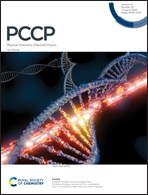The optimal co-doping of SrFe1−xCoxO3−δ oxygen carriers in redox applications
Abstract
Although the oxygen carrier SrCoO3 has higher redox activity than SrFeO3, cobalt is both more expensive and scarcer than iron, which would hinder the wide implementation of SrCoO3. For these reasons, doping SrFeO3 with Co is a potential compromise, benefitting the redox properties of SrFeO3, while still limiting the overall amount of cobalt being used. To find the optimal level of Co-doping, density functional theory calculations were performed to investigate the Co-doping effect on the oxygen vacancy formation and oxygen migration in SrFe1−xCoxO3−δ (x = 0, 0.125, 0.25, 0.375, 0.5). Our findings show that the oxygen vacancy formation energies (Ef) decrease with the increase of Co content resulting from the increased composition of the O-2p band at the Fermi level upon Co doping. In particular, the Ef decreases nearly 0.5 eV between the x = 0 and x = 0.25 samples while Ef only decreases 0.1 eV further as Co content is increased to x = 0.5. We obtain that x = 0.25 is an optimal cost/benefit ratio for Co doping, which is preserved at both low oxygen vacancy concentrations (δ = 0.0625 values listed above) and at high concentrations of δ = 0.1875 and 0.375. Kinetically, the oxygen migration barrier has slight change upon Co doping due to the similar size of Co and Fe. Therefore, considering both redox activity and economics in reversible oxygen storage applications, x = 0.25 is suggested as the optimal Co-doping value in SrFe1−xCoxO3−δ.



 Please wait while we load your content...
Please wait while we load your content...